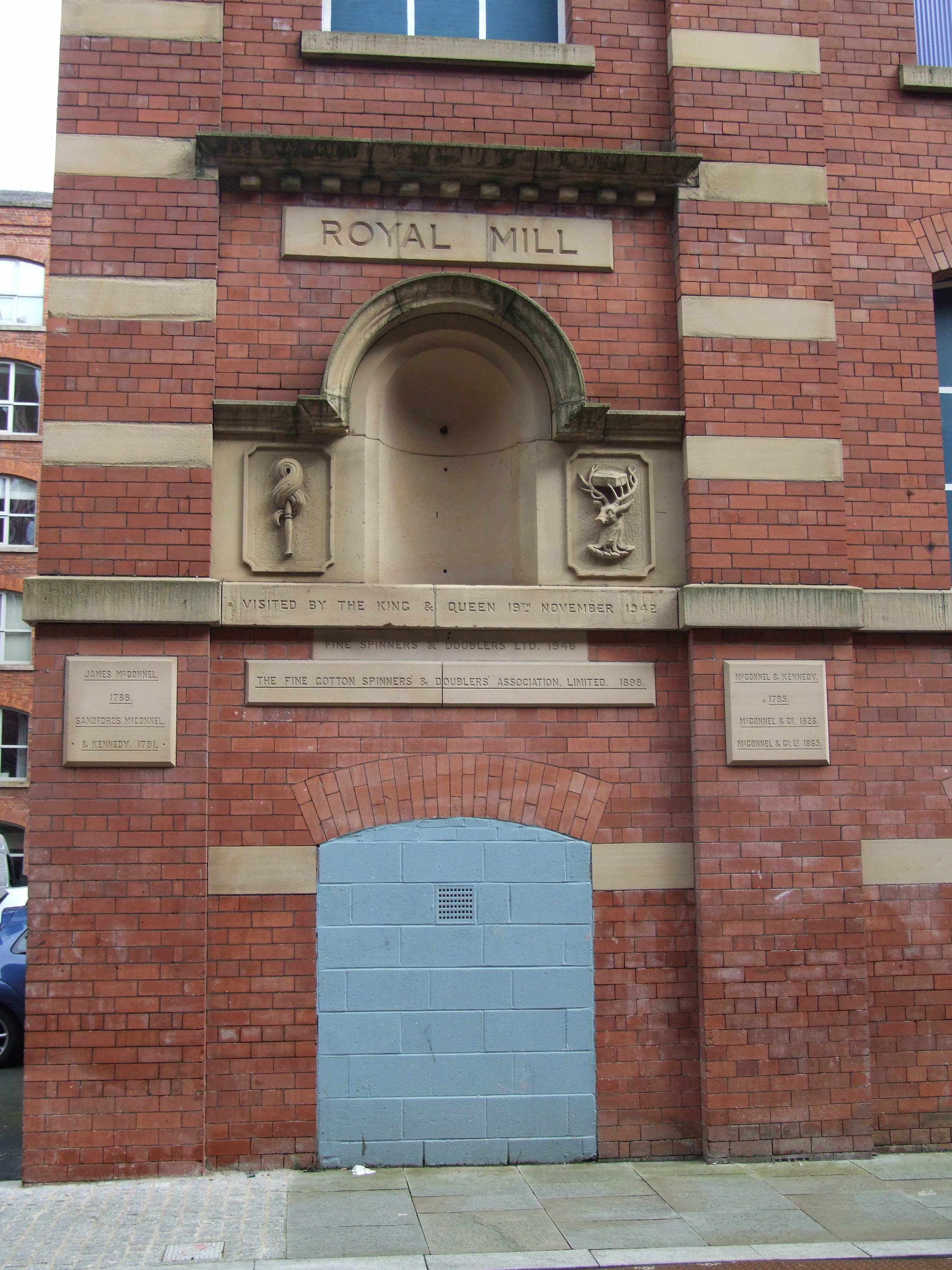Royal Mill on:
[Wikipedia]
[Google]
[Amazon]
Royal Mill, which is located on the corner of Redhill Street and Henry Street, Ancoats, in

Manchester
Manchester () is a city in Greater Manchester, England. It had a population of 552,000 in 2021. It is bordered by the Cheshire Plain to the south, the Pennines to the north and east, and the neighbouring city of Salford to the west. The t ...
, England, is an early-twentieth-century cotton mill, one of the last of "an internationally important group of cotton-spinning mills" sited in East Manchester. Royal Mill was constructed in 1912 on part of the site of the earlier McConnel & Kennedy mills, established in 1798.
It was originally called New Old Mill and was renamed following a royal visit by King George VI and Queen Elizabeth in 1942. A plaque commemorates the occasion. The Ancoats mills collectively comprise "the best and most-complete surviving examples of early large-scale factories concentrated in one area".
Location
Redhill Street in Manchester was home to two large spinning companies, A&G Murray Ltd and McConnells. Historically this area of Manchester had used the waters of the Shooters Brook to power the waterwheels on Salvins Factory and the New Islington Mill. The Rochdale Canal runs alongside the street and the mill. Originally used for transport, the canal had provided water to Murrays and McConnells for the condensers of their steam engines.History
McConnells had joined Fine Spinners and Doublers Association Ltd in 1898. In 1910 it was investing again, and rebuilt two mills and was experimenting with electricity.The building
The New Old Mill like the Paragon Mill was built in theEdwardian Baroque
Edwardian architecture is a Neo-Baroque architectural style that was popular in the British Empire during the Edwardian era (1901–1910). Architecture up to the year 1914 may also be included in this style.
Description
Edwardian architecture is ...
style by H. S. Porter
H is the eighth letter of the Latin alphabet.
H may also refer to:
Musical symbols
* H number, Harry Halbreich reference mechanism for music by Honegger and Martinů
* H, B (musical note)
* H, B major
People
* H. (noble) (died after 1279 ...
using Accrington brick
Accrington bricks, or Nori, are a type of iron-hard engineering brick, produced in Altham near Accrington, Lancashire, England from 1887 to 2008 and again from 2015. They were famed for their strength, and were used for the foundations of the B ...
and terracotta
Terracotta, terra cotta, or terra-cotta (; ; ), in its material sense as an earthenware substrate, is a clay-based unglazed or glazed ceramic where the fired body is porous.
In applied art, craft, construction, and architecture, terracotta ...
. It had cast iron
Cast iron is a class of iron– carbon alloys with a carbon content more than 2%. Its usefulness derives from its relatively low melting temperature. The alloy constituents affect its color when fractured: white cast iron has carbide impur ...
columns supporting by transverse steel beams and reinforced concrete floors. Initially both were built as 5-storey, though eventually 6-storey, 9 bay mills. The machines were electrically group driven. The electricity supply was provided by the corporation and a new substation was built in 1915.
Listing
The mill has been a Grade II* listed building since 11 November 1988. Royal Mill, and its companion Paragon Mill, are "six-storey and nine bay buildings designed to house electrically-powered mules, the first generation of those purpose built for electricity." After decades of neglect and decay, a restoration scheme costing £65 million was announced by ING Real Estate in 2003, which would see the building converted for use as flats, offices and shops. The work received an award from theRoyal Institution of Chartered Surveyors
The Royal Institution of Chartered Surveyors (RICS) is a global professional body for surveyors, founded in London in 1868. It works at a cross-governmental level, and aims to promote and enforce the highest international standards in the va ...
in 2007, and began to be occupied in 2008. Some of the original features have been retained, including the exposed brickwork and items of mill machinery.
See also
*Grade II* listed buildings in Greater Manchester
There are 236 Grade II* listed buildings in Greater Manchester, England. In the United Kingdom, the term listed building refers to a building or other structure officially designated as being of special architectural, historical or cultural ...
*Listed buildings in Manchester-M4
Manchester is a city in Northwest England. The M4 postcode area is to the northeast of the city centre, and includes part of the Northern Quarter, part of New Islington, and the area of Ancoats. This postcode area contains 67 listed b ...
References
Bibliography
* * * {{Lancashire Cotton Textile mills in Manchester Former textile mills in the United Kingdom Cotton mills Spinning History of Manchester Grade II* listed buildings in Manchester Grade II* listed industrial buildings Edwardian architecture